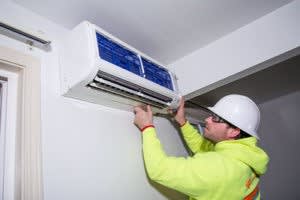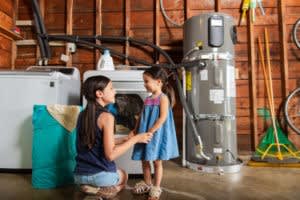It’s Electric
The race to electrify every house in the U.S. is moving fast. The most populous state in the country has passed energy codes that incentivize electric appliances and efficient heating and cooling systems, a move that could wind down the use of fossil fuels in buildings.
The codes approved by the California Energy Commission will affect all new residential construction and some businesses, including motels, medical offices, retail and grocery stores, and restaurants among others. The energy codes are updated on three-year cycles. When we last checked in on them in 2018, they were updated with a mandate to include rooftop solar on all new construction. The new codes are focused on bringing energy-efficient appliances and phasing out gas hookups for homes in the California.
Choosing household heating, hot water, and cooking appliances is probably a tedious chore unless you’re a big HGTV fan. Most of us approach it like any other choice: What will make my living space the most comfortable? What’s low maintenance? How much will it cost, upfront and in the long run? Does this purchase align with my personal morals (if you’re among the
70 percent of Americans who are worried about climate change, this one’s becoming a biggie)?
One of the First Choices Is the Most Consequential: Gas Vs Electric Appliances?
There’s a lot to consider when faced with that choice. RE Sources, and plenty of others before us, have made the case that all-electric homes are one of the best ways to
save on construction costs and reduce extreme-weather-causing carbon emissions. Since gas is one of Washington state’s biggest sources of climate pollution, and a growing body of research highlights the
health effects of burning gas in our buildings, there is a movement towards constructing new buildings that run entirely on electricity. But most of us don’t live or work in new buildings, so it’s important to know our options as consumers.
Since it’s an important consideration, let’s address the “cost” elephant in the room right off the bat. Here’s a little context for Washington state specifically:
Our state’s electricity is already among the lowest-cost and lowest emissions in the country—about 80 percent cleaner than the national average. Sixty-five percent of the state’s electricity supply comes from local, renewable energy sources like hydropower and wind, and is growing every year.
While it’s true that efficient electric appliances cost a little more upfront and electricity costs slightly more per unit of energy than gas today, efficient electric appliances use far less energy overall. In Seattle, the all-electric home saves $4,300 in net present costs (present value of all costs of installing and operating electric appliances over their lifetime, minus the present value of all the revenues that it earns over the project lifetime) and 28 tons of CO2 emissions over a 15-year period. We use this data because Seattle has been well-studied, but residents across Northwest Washington likely see comparable savings.
More on how electric options are poised to become the most affordable option later. But first…
Gas Vs Electric Appliances: The Big Picture
Before looking at the options to heat our homes, get hot water, and cook, let’s dispel a couple of common misconceptions about gas appliances.
One, most gas appliances will not work in power outages. Heating systems need electric fans to move heat. Fireplaces are the same. Many modern gas stoves have electric starters, and it’s not safe to light them on your own. Some tank gas water heaters don’t require power if the pilot light is lit, but it’s model-specific.
Two, gas appliances are not as safe or healthy as the oil and gas industry leads people to believe. Children living in homes with a gas stove have a
42 percent increased risk of having asthma symptoms and a 24 percent higher risk of developing asthma later in life. Many vent hoods on stoves just move air around the house and don’t actually move the harmful compounds found in gas—like nitrogen oxides and carbon monoxide—out of the house.
A (Quick) Breakdown of the Options for Gas Vs Electric Appliances
Induction Cooking: Not Your Grandpa’s Electric Coil Range
Most peoples’ cooktop preferences align with what they learned to cook on — polling data shows a pretty even split between standard electric stoves and gas-burning ones. But what if we told you there’s a third option that heats faster and is much safer (i.e., not a fire risk because it cannot be accidentally turned on and doesn’t
emit unhealthy substances like gas does)?
Induction cooking, which is already popular in many parts of the world for its ease and affordability, is gaining traction in the U.S. It works by using magnets to excite metals in your cookware, heating the pan directly — no flame, no red-hot coil. And a plug-in countertop single burner costs just
$80. You can adjust the settings to precise temperatures, and the heat change is immediate. Induction is more powerful than both standard electric and gas,
boils water minutes faster, and uses much less energy. From
EnergyStar: “If all cooktops sold in 2021 in the U.S. used induction technology… the energy cost savings would exceed $125 million and the energy savings would exceed 1,000 GWh.” They’re also very easy to clean because the flat surface doesn’t stay hot, so drips and splatters don’t burn onto the element.
The one catch is your cookware must be magnetic. But most good pots and pans, including cast iron and stainless steel, work great. Just grab a fridge magnet to test if your pans are induction-ready.
Many professional chefs also love the flexibility and speed that induction offers. See why:
Space Heating: Heat Pumps Are 3-4 Times More Efficient Than Other Sources (and They Provide a/c)
Did you know that one type of heater — the humble heat pump — can cool your home as well as warm it? As hotter summers become the norm in the Northwest, heat pumps will be more efficient and cheaper to run over standard air conditioning units. During the 2021 record-breaking heatwaves, which contributed to
hundreds of deaths in the Northwest,
portable AC units flew off shelves. Cool homes in the summer are as important as warm homes in the winter for safety. On top of being highly efficient, a common misconception is heat pumps don’t work in cold climates,
but they perform well in the cold and have even worked in chilly Minnesota.
Most gas space heating systems are centralized forced-air systems. With electric heat, there are lots of efficient options to consider: forced air, heat pumps, radiant ceiling panels (the RE Sources office stays cozy with these!), heated floors, individual wall units, and more. Chances are at least one of these electric systems will make sense for your home, though heat pumps will offer the best long-term savings and eliminates the need for separate A/C.
Induction Hot Water Heaters Use Up to 66 Percent Less Energy
photo courtesy of NEEA
After space heating, hot water typically accounts for the
second-largest portion of a home’s energy use and greenhouse gas emissions. Electric heat pump water heaters (HPWH) are three times more efficient than standard electric or gas water heaters, providing a super-efficient hot water solution powered by Washington’s increasingly clean electricity.
Operating a heat pump water heater is comparable in cost to gas, and 60 percent less than a standard electric water heater. Utility incentives may be available as well — check with your power provider. Heat pump water heaters currently require a 240 volt dedicated circuit, but 120-volt water heaters are coming to market soon. If you already have a standard electric water heater, you will already have a 240-volt circuit!
Policy Decisions and Fossil Fuel Industry Decline Means Electric Will Soon Be the Most Affordable Option
Gas is strongly preferenced in state code and fossil fuels are heavily subsidized, making gas artificially cheaper. Clean electricity is growing more affordable and programs at local, state, and federal levels could make the upfront costs on par with gas. While electricity costs more per unit of energy, efficient appliances use much less energy than gas, leading to savings. The gas industry’s answer to their pollution problem is renewable natural gas, which is more expensive than regular gas *or* electric (
and isn’t, in fact, renewable). In Washington, it’s illegal for public utilities to give financial breaks for switching from gas to electric, which adds another roadblock and gives the fossil fuel industry a tighter grip on the market. Investor-owned utilities like Puget Sound Energy, however, can and should support customers seeking fully electric homes.
What About the Increased Demand for Electricity When We Transition Off Gas?
While a majority of the Northwest energy mix is already generated from clean sources like hydro, wind, and solar today,
about 25 percent of the region’s energy capacity comes from fossil fuel generators—sources that will largely be eliminated in the coming decade per the
Clean Energy Transformation Act. Clean power sources are needed to both replace existing fossil fuel generators and to serve new consumer loads like electric cars and electric heating. To meet the state’s decarbonization objectives, electricity demand is expected to double by 2050. These increasing electricity demands won’t all happen at once. It will phase in over the next 30 years giving time for our region’s power providers to beef up the power grid and acquire new renewable energy as fossil fuel generation is phased out.
RE SourcesGas

